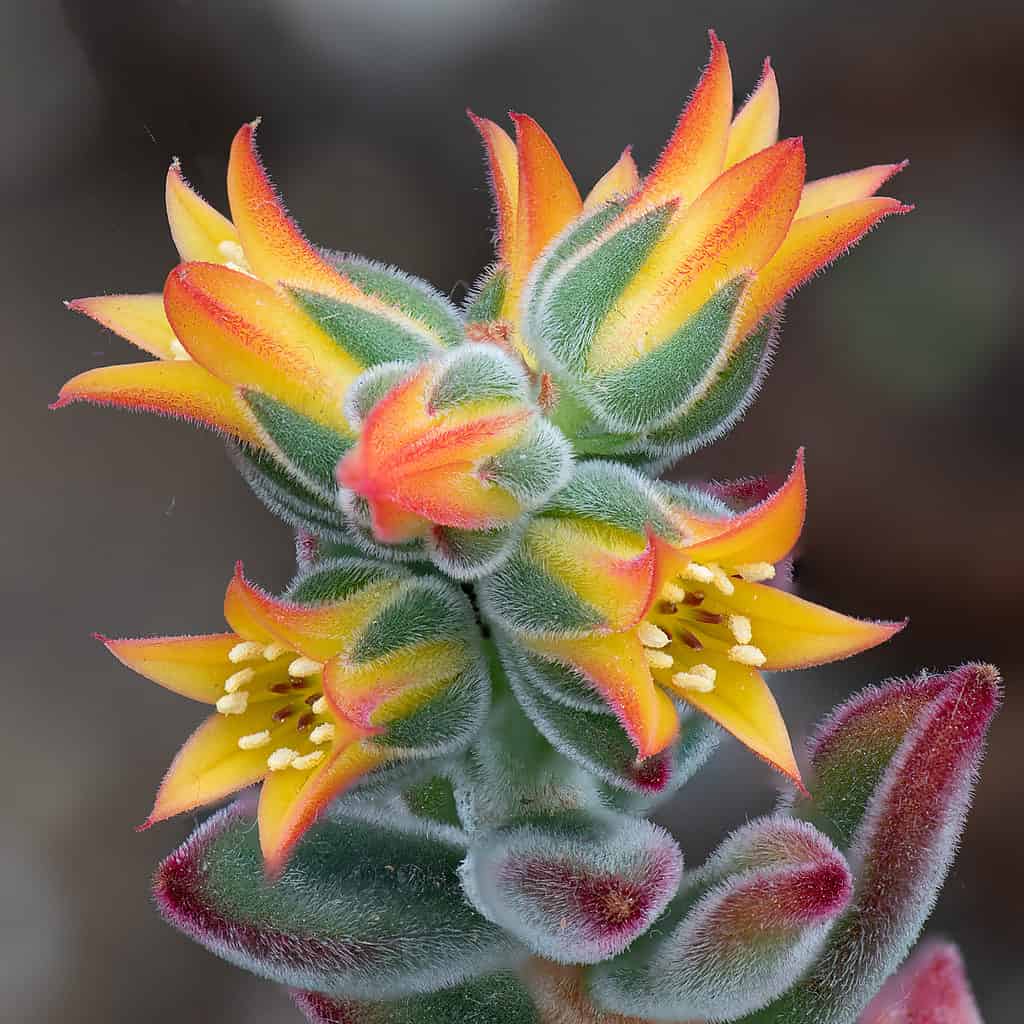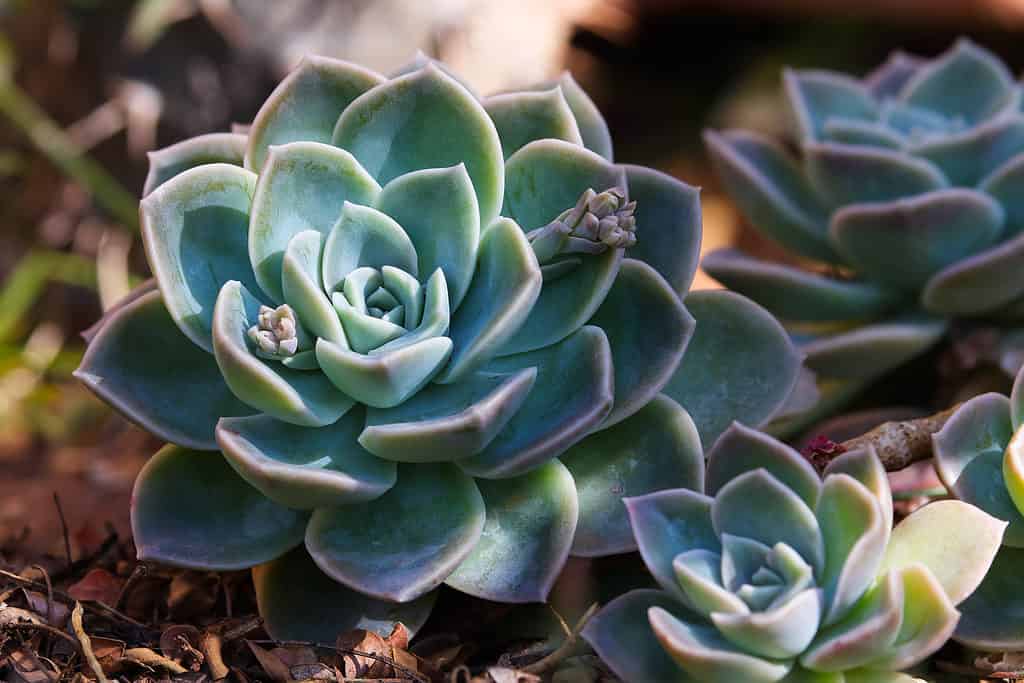As the heat of summer approaches, it is important to take proper care of succulent plants. Whether you have them in their natural environment or a pot, here are some helpful tips to ensure that your succulents remain vibrant and healthy.
What is a Succulent?

Chenille plant succulent has rosettes of red-tipped leaves and yellow and red flowers.
©Michael Eaton/Shutterstock.com
Confusion can arise when trying to understand gardening terminology. In brief, succulents originate from arid climates and have fleshy stems and leaves that store water. This term describes sedum, aloe, cacti, kalanchoe, agave, sempervivum, echeveria, crassula, and many other species.
Nonetheless, the word “succulent” is typically used to refer to those with fleshy, thick leaves. Succulents with spines are called cacti, although they are technically very similar. This guide will help you care for your succulent plants during the summer.
Water
Caring for succulents in the summer can be tricky. Many people are under the wrong impression that they don’t need to be watered or only need a small amount of water. Succulents require less frequent water than other plants but must be watered deeply and thoroughly.
Outdoor and in-ground succulents usually need water once every ten days or so, while indoor succulents are sometimes thirsty as often as once a week. If the succulent is planted in a black plastic pot, it should be checked more often, as the black color of the pot can increase the temperature around the plant.
It is important to make sure that succulent plants receive enough water. If their soil is allowed to dry out completely, the fine root filaments may suffer, and the plant’s growth may be stunted or cease. To check if the soil in a pot is moist, you can insert a chopstick or wooden dowel, and if the dirt clings to it when you pull it out, it is not time to water yet.
Another way to check if a succulent needs water is to stick a finger at least an inch into the soil. If it feels dry, then it needs to be soaked. It is best to water them in the morning so they have time to dry before nightfall.
Soil
A succulent’s soil should be well-draining, so it is important to ensure the potting mix you choose has that quality. If you opt for a pre-mixed option, make sure it is designed specifically for use with succulents.
If making your own soil blend, combine regular potting soil with sand or small pebbles or gravel to create a loose, airy texture that will promote drainage and help prevent waterlogging.
Adding some organic matter (like peat moss, compost, or aged manure) can also be beneficial. These additions will provide essential nutrients and trace minerals necessary for healthy plant growth.
Light and Heat

Narrow-leaved Haworthia is a type of succulent.
©TatjanaVer/Shutterstock.com
You can take indoor succulents outside in the summer. These plants do great when kept outdoors due to the abundant sunlight and airflow, but you should gradually move them into a sunny spot. When more sunlight is available outdoors, succulents can burn in the summer. So, take your time and let them get slowly acclimated.
Large succulents can withstand longer periods of direct sunlight, while baby succulents should only receive a few hours each week. Early morning sun is the best for them while they get used to the move.
Keep an eye out for symptoms of sunburn, such as color change or bleaching, and move the plants back to a shadier area if any of these issues arise. If the succulents are stretched out towards the sun, this may indicate that they need more sun and should be moved to a brighter spot.
Remember that heat and sun combined is dangerous for some of the more delicate plants. Most succulents with smooth leaves require protection from the sun when temperatures rise above 80 degrees.
Orientation and Placement
Understand which direction your residence faces to the sunlight. In North America, plants growing in the north of your house will get the least sunlight, while those in the south will get the most. East-facing gardens will be exposed to the morning sun and shaded in the afternoon. In contrast, those facing west will have afternoons in the sun and shade in the mornings.
Bright shade, where there’s no direct sunlight without being deeply shaded, is best for non-desert succulents in the hottest part of the day. Bright shade is perfect for succulents that need low light, such as haworthias.
Ensure aloes and crassulas are exposed to enough sunlight to take on red and orange tones. However, take care not to overexpose the plants to the sun as this could lead to their leaf tips drying out or being burned. They should have at least a minimum of half a day of sun.
Succulent Care: Timing

Succulent blue rock rose (
Echeveria imbricata) growing in garden.
©iStock.com/JJ van Ginkel
Timing is everything when it comes to moving your succulents outdoors. Before planting your succulents outside, ensure the nighttime temperatures don’t drop below 40F. It would be best if you also waited until after the season’s last frost has passed.
Waiting too long into summer can be just as detrimental for your succulent plants because of the extreme heat. Therefore, it’s best to plant them when the weather is between 50-70F for outstanding success.
To ensure that your succulents remain safe and healthy during this transition period, take extra precautions, such as covering them with a light sheet at night or providing shade during peak hours of sunlight exposure. Additionally, you’ll want to keep an eye on their soil moisture levels and adjust watering if they become dry or overly saturated due to sudden changes in temperature or precipitation levels.
Protection
Cover horizontal stems of trailing succulents such as senecios, aloes, and othonna with mulch or dried leaves to prevent sunburned stems and ensure proper moisture transmission.
Protect newly planted succulents and those prone to sun-scorch using shade cloth, old sheets, or floating row covers. Alternatively, set up leafy branches around the plant on the side with the most direct sunlight. For more protection, use outdoor furniture that can be moved as the sun shifts through the day.
When succulents display beige, white or black splotches on their leaves, they have been sunburned. Even though the plant is still okay, the damage caused by the sunburn will remain visible until the leaf eventually falls off.
If the sun has caused damage to the outer leaves of your succulent, this is not a problem, as new foliage will grow and hide the discolored areas. The lower leaves will eventually fall off regardless of whether they have been damaged. Depending on the succulent species and the time of year, it can take a few months up to a year for the plants to fully recover from sunburn.
Succulent Care: Food
For your succulents to remain healthy during the summer, you should feed them a diluted fertilizer with every other watering. Most liquid plant fertilizers that contain balanced amounts of phosphorous, nitrogen and potash (10-10-10, for example) are recommended. When mixing the fertilizer, follow the directions on the bottle but use half the amount normally suggested. It is especially important to use fertilizer if you have many succulents in one small container, like a terrarium.
Propagation

Sempervivum thrives in dry, hot conditions.
©iStock.com/mdragan
When succulents are in a favorable environment, they often self-propagate. Many succulents are quite easy to propagate. You can usually detach a piece where it connects to the plant and put it on top of well-draining soil, and you should see roots begin to grow within a few weeks.
Certain succulents can even develop roots without soil! The Christmas cactus is an example of this, and it is a popular houseplant. If you accidentally knock off a piece of the cactus, a brand new plant will grow from that one piece without any specific care.
Pests
In the summer, only a few pests can cause harm to succulent plants; mites, mealybugs, rodents, birds, and snails. To limit potential pest damage, use repellents and exclusion methods such as netting around the plants. If you notice small white fluff, they are likely to be mealybugs. You can hose them off or use insecticidal soap to get rid of them. Also, check the roots, as pests love to inhabit this area.
Up Next
The photo featured at the top of this post is © FarOutFlora, CC BY 2.0
Thank you for reading! Have some feedback for us? Contact the AZ Animals editorial team.






